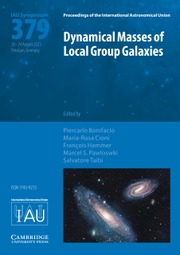Article contents
Star clusters and young populations in the dwarf irregular galaxy Leo A
Published online by Cambridge University Press: 30 October 2019
Abstract
We have studied young stellar populations and star clusters in the dwarf irregular galaxy Leo A using multicolor (B, V, R, I, Hα) photometry data obtained with the Subaru Suprime-Cam and two-color photometry results measured on archival HST/ACS F475W & F814W frames. The analysis of the main sequence (MS) and blue supergiant (BSG – “blue loop”) stars enabled us to study the star formation history in the Leo A galaxy during the last ~200 Myr. Also, we have discovered 5 low-mass (≲ 400 M⊙) star clusters within the ACS field. This finding, taking into account a low metallicity environment and a yet-undetected molecular gas in Leo A, constrains star formation efficiency estimates and scenarios. Inside the well known “hole” in the H i column density map (Hunter et al. 2012) we found a shock front (prominent in Hα), implying an unseen progenitor and reminding the “hole” problems widely discussed by Warren et al. (2011).
Information
- Type
- Contributed Papers
- Information
- Proceedings of the International Astronomical Union , Volume 14 , Symposium S344: Dwarf Galaxies: From the Deep Universe to the Present , August 2018 , pp. 139 - 142
- Copyright
- © International Astronomical Union 2019
References
- 1
- Cited by

